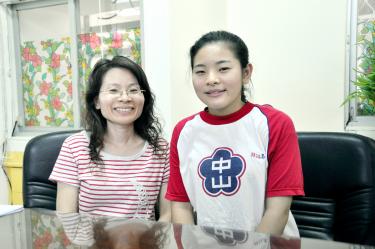Heavy school bags, bad posture can lead to scoliosis
A heavy school bag and bad posture could lead to scoliosis, or curvature of the spine, and the progression rate is especially fast during childhood and adolescence. Doctors say that girls are more likely to develop scoliosis than boys because girls grow faster. Besides a sore waist and an aching back, scoliosis could have a negative effect on cardiopulmonary function. In cases of severe scoliosis, surgery is necessary.
Lo Hao-ju, a doctor in the orthopedics department of Taipei City Hospital’s Renai branch, says that the causes of scoliosis have yet to be discovered, but bad posture and carrying an overweight school bag are possible contributory factors. X-rays are usually taken to assess the degrees of spinal curvature: less than 20° is considered mild; between 20° to 45° is considered moderate; and greater than 45° is considered severe.
Scoliosis can lead to humpback or uneven shoulders. Given that scoliosis causes long-term imbalance in muscle development, children with scoliosis often complain of back pain, and when they reach old age, they are likely to fall victim to sciatica. In severe scoliosis, the deformities may put pressure on a patient’s lungs and heart, thus affecting their respiratory and cardiovascular systems or even disrupt the patient’s ability to move and affect their quality of life.
Wu Chun-chieh, a doctor in the physical rehabilitation department at Taipei City Hospital’s Zhongxing branch, says that most scoliosis cases are S-shaped, with one half of the curve to the left, and the other half to the right. Simply correcting one’s everyday posture is usually sufficient for people with mild scoliosis. People with moderate curvature are required to do rehabilitation exercises to improve muscle strength or to wear a brace to correct the deformity. Severe scoliosis requires surgery — a major operation with potential risks involved — to correct the disorder. If the curve progresses by 5° or more per year, surgery is recommended.
Kao Mu-jung, head of the rehabilitation department of Taipei City Hospital, says that an average of 10 percent of school-aged children could potentially develop scoliosis. As they enter adolescence, the curvature may progress more rapidly to show symptoms. A comprehensive health exam at school could help alert parents to the condition in their children at an early stage. If scoliosis is suspected, people can go to a hospital for a professional follow-up and rehabilitation exercises to improve the condition.
(Liberty Times, Translated by Lin Ya-ti)
TODAY’S WORDS 今日單字
1. posture n. 姿勢
例: You can tell that she is a ballet dancer by simply looking at her standing posture.
(從她的站姿即可看出她是一位芭蕾舞者。)
2. sore adj.痛的
例: Lactic acid buildup can cause sore muscles.(乳酸積聚可導致肌肉痠痛。)
3. imbalance n. 不均衡
例: Dietary imbalances can lead to many chronic illnesses. (飲食不均衡可導致許多慢性病。)
書包太重、姿勢不良都可能造成脊椎側彎,尤其是兒童與青少年,惡化速度更快。醫師提醒,女生因為成長速度較男生快,側彎比例也較高。脊椎側彎不但導致腰痠背痛,還可能壓迫心肺功能,嚴重者須開刀治療。
北市聯合醫院仁愛院區骨科醫師羅浩儒說,目前尚無法確知脊椎側彎發生原因,但姿勢不良或背太重書包都是惡化因子;判斷脊椎側彎是透過X光檢查,彎曲角度二十度以內是輕微側彎,二十至四十五度是中度,四十五度以上則是重度。
羅浩儒說,脊椎側彎可能導致駝背,或讓肩膀看起來一高一低,長期身體兩側肌肉發展不平衡,小朋友常腰痠背痛,直到老年更是坐骨神經痛;嚴重還可能擠壓到心臟與肺臟,呼吸與心臟系統受影響,更進一步影響運動或生活功能。
聯合醫院中興院區復健科主任醫師武俊傑表示,大部分的脊椎側彎是彎成S型,一半往左彎、一半往右彎,輕度側彎僅需調整平日身體姿勢,中度須靠復健訓練肌肉,或穿背架矯正,重度則需開刀,算是有風險的大手術,建議若每年側彎角度增加五度以上,最好開刀處理。
聯合醫院復健部主任高木榮醫師說,平均有百分之十學童有潛在脊椎側彎的可能,隨青春期的到來,可能快速變壞、外顯出脊椎側彎問題。學校全面的健檢可提供家長及學童及早發現脊椎側彎問題,也可透過醫院的追蹤與專業的復健,給予特殊復健運動指導等,進行改善。
(自由時報記者張傳佳、郭安家)

No comments:
Post a Comment